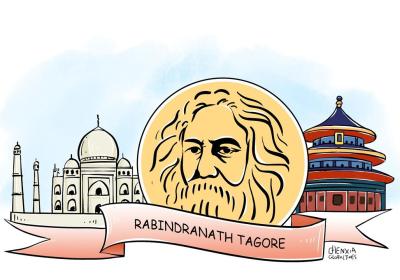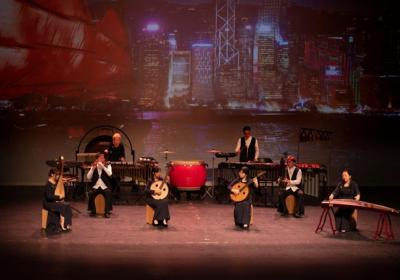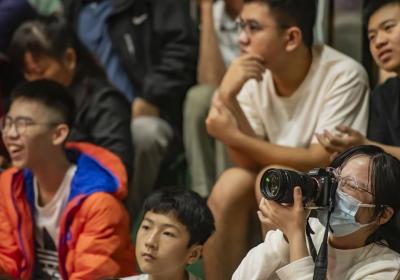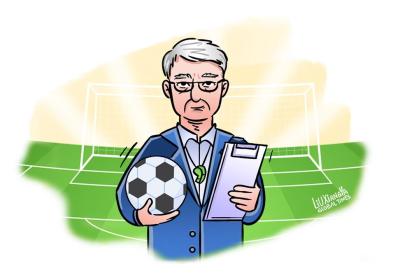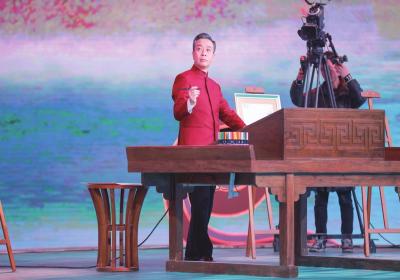
Wang Xiaowei (left), director of the Dunhuang grottoes monitoring center of the Dunhuang Academy, gives a speech to the Afghan delegation. Photo: Gao Ying/GT
Positioned at the crossroads of Eastern and Western civilizations, Afghanistan is often referred to as the "Crossroads of Central Asia," with its culture impact influencing the regions along the ancient Silk Road.
In the No.61 cave at the Mogao Caves in Dunhuang, Northwest China's Gansu Province, a mura created during the Five Dynasty (907-960) period, depicts the history of an Afghan monk visiting the Wutai Mountain in North China's Shanxi Province.
The ancient connection between Afghanistan and China is not limited to a single wall painting. Lazurite, a deep-blue colored mineral of which Afghanistan is considered a major source, has been widely used in the mural art works in Dunhuang.
Boasting a history of more than 5,000 years, Afghanistan now harbors two UNESCO World Heritage sites: Minaret and the Archaeological Remains of Jam as well as the Cultural Landscape and Archaeological Remains of the Bamiyan Valley.
But after years of conflicts, international sanctions as well as natural disasters, the country's cultural preservation efforts are in need of a helping hand, said Shao Xuecheng, a researcher at the Institute of World Art History at Shanghai International Studies University.
Miao Bin, a deputy director of the Department of International Exchange, the Central Academy of Cultural and Tourism Administration, said that an Afghan delegation was originally scheduled to visit China in October, but an earthquake in northwestern Afghanistan earlier that month delayed the trip as some members were once out of contact.
Seeking cooperationThough harboring two UNESCO World Heritage sites, Afghanistan is actively seeking international assistance to strengthen its efforts in domestic cultural heritage preservation.
A total of 24 Afghanistan cultural experts paid a 21-day visit to China in November, seeking cooperation with China.
Speculations were once rampant that the Afghan government does not regard cultural heritage protection as an important issue, which ultimately led to the smuggling of artifacts.
Sibghatullah Abid, director of the National Museum of Afghanistan, dispelled rumors, saying "Afghanistan's commitment to cultural heritage preservation is evident."
In an effort to seek international assistance for the restoration of historical sites in Afghanistan, Mawlavi Atiqullah Azizi, a deputy minister of Culture and Information of Afghanistan, met with UNESCO Culture Program Officer Brendan Cassar in Janaury.
"The gap in cultural heritage protection between Afghanistan and China is like the distance from Earth to Mars," Hussain Ali Haidari, an Afghan archaeologist, told the Global Times when he was among the Afghan delegation visiting Dunhuang.
Haidari's statement may underscore the significant disparity in cultural heritage preservation between Afghanistan and China, but the experience of the Dunhuang Academy in the conservation of grottoes and ancient sites can definitely serve as a valuable model for Afghanistan.
The academy, once a marginal bureau in preserving the Mogao Caves after the establishment in 1944, has grown to be a world-leading institute that oversees the grottos and murals in its base in Dunhuang.
Zekriya Oriyakhail, director of the Department of Protection and Restoration at the Afghan Ministry of Culture and Information, said Afghanistan's abundant artifacts can be particularly found along the ancient Silk Road.
Under the Belt and Road Initiative (BRI), China has been actively contributing to the preservation of Afghan cultural heritage.
Su Bomin, chief of the Dunhuang Academy, mentioned that the academy has intensified research on Silk Road cultural exchange in recent years, with Afghanistan being a crucial area of study.
Scholars from the academy have already conducted academic investigations in Afghanistan and other Central Asian regions, Su noted.
Challenges aheadThough severely damaged in a 2001 blast and now listed as an endangered World Heritage Site, the Bamiyan Caves officially reopened to the world in May 2022, with all tourist facilities functioning normally. However, the reality is that the caves still require urgent protective measures.
The decision to focus the Afghan training program on Dunhuang stems from the similarities between the Bamiyan Caves and Mogao Caves in terms of cultural relic restoration and protection.
However, the road to preserving Afghan cultural heritage is fraught with challenges. One major hurdle is the lack of equipment.
"Through our study at the Dunhuang Academy, we realized many of our shortcomings, especially in terms of equipment," Abid told the Global Times, acknowledging their deficiency.
Afghanistan relies heavily on imports for goods. Due to international sanctions, upgrading technical equipment for projects related to cultural heritage preservation is challenging.
Another obstacle is the shortage of skilled personnel. While Afghanistan is home to a vast number of national monuments and ancient sites, it lacks sufficient professionals in technical and monitoring roles.
Furthermore, disseminating knowledge in the cultural and museum sector faces difficulties due to a thin foundation in Afghanistan's printing and publishing industry.
Despite improvements in Afghanistan's security situation, the risk level for tourism is still considered high, which may affect the safety of experts supporting cultural heritage protection in the country. But the claim was rejected by Oriyakhail, who underlines that now Afghanistan is safe across the country.
Oriyakhail also noted that Afghanistan has documented more than 2,300 cultural heritage sites and protected and restored more than 350 immovable cultural heritage sites in the country.
Sultan Masoud Muradi, director of Archaeology at the Afghan Ministry of Culture and Information, noted that China and Afghanistan shared a common starting point in cultural heritage protection over a century ago.
"Both nations faced cultural looting and destruction by Western powers before officially initiating conscious efforts to protect their heritage in 1921," Muradi said.
"Afghanistan experienced plundering of its artifacts and monuments by Western individuals in the 19th century. The country has been actively safeguarding its cultural heritage since 1921."
After the visit to Dunhuang, many Afghan officials have expressed a willingness to invite Chinese experts to work on cultural heritage projects in Afghanistan.
As the BRI fosters collaboration, China's experiences in preserving cultural heritage like the Mogao Caves would definitely boost bilateral relations, experts said.


